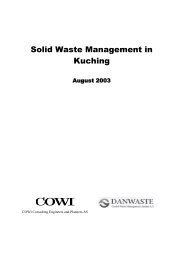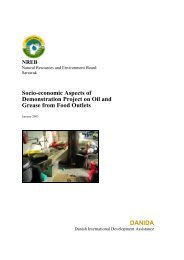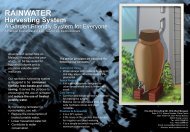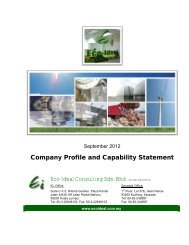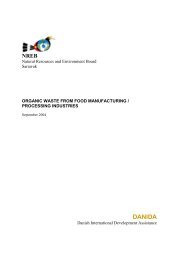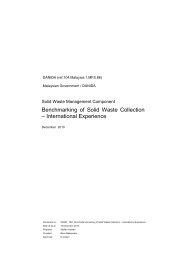source separation of food waste - turning waste into compost
source separation of food waste - turning waste into compost
source separation of food waste - turning waste into compost
Create successful ePaper yourself
Turn your PDF publications into a flip-book with our unique Google optimized e-Paper software.
CHALLENGES AND KEY LESSONS LEARNT<br />
The project has overcome a number <strong>of</strong> challenges. They are discussed as follow:<br />
• INCENTIVES TO INCULCATE FOOD WASTE SEGREGATION AT SOURCE<br />
Segregation <strong>of</strong> <strong>food</strong> <strong>waste</strong> to become a routine for the hawkers is crucial for the success <strong>of</strong> the project. Besides<br />
organising awareness activities to stir interest, possible incentives may be awarded to ensure participation. Giving<br />
away free <strong>compost</strong> and gardening kits to participating hawkers can be an effective way <strong>of</strong> sustaining their interest<br />
in practising <strong>food</strong> <strong>waste</strong> segregation and encouraging them to practise gardening, towards healthy lifestyle.<br />
• SCREENING AND PROCESSING OF FOOD WASTE<br />
During the operation, some <strong>food</strong> <strong>waste</strong>s received at the <strong>compost</strong>ing facility were found to be mixed with non-<strong>food</strong><br />
<strong>waste</strong> materials such as fork and spoons, straws, chopsticks, etc. By simple screening processes, it has been<br />
possible to manually sort out these materials. Further, it was found that the <strong>food</strong> <strong>waste</strong> contains very high moisture<br />
and oil content. It is therefore, recommended that the <strong>food</strong> <strong>waste</strong>s should be drained before being fed in to the<br />
<strong>compost</strong>ing machines to reduce the liquid load to the machines. Oil and grease trap should be installed to cater for<br />
the water drained <strong>of</strong>.<br />
According to the machine’s specification, <strong>food</strong> <strong>waste</strong> can be processed <strong>into</strong> <strong>compost</strong> within 24 to 48 hours<br />
depending on the <strong>waste</strong> composition. However, the actual operation shows that 48 hours is the optimum process<br />
duration for producing better qualities <strong>of</strong> more matured <strong>compost</strong>s.<br />
• ALTERNATIVE METHOD FOR COMPOSTING<br />
In this project, the <strong>compost</strong>ing was done using advanced in-vessel high-speed <strong>compost</strong>ing machine which utilises<br />
mechanical <strong>turning</strong> and temperature control. This method requires very short time to achieve <strong>compost</strong>ing but it<br />
requires high investment and operating costs, i.e. energy (electricity). There are other alternatives available which<br />
can be considered such as conventional windrow, aerated chamber <strong>compost</strong>ing and bin <strong>compost</strong>ing methods.<br />
These conventional methods imply less capital costs and consume less energy. They do, however, require longer<br />
<strong>compost</strong>ing period and have larger land requirements. Windrow <strong>compost</strong>ing in particular, requires large space or<br />
land to carry out the <strong>compost</strong>ing process. Detailed comparison <strong>of</strong> the pros and cons <strong>of</strong> these alternative<br />
<strong>compost</strong>ing methods will depend on the local conditions.<br />
18



